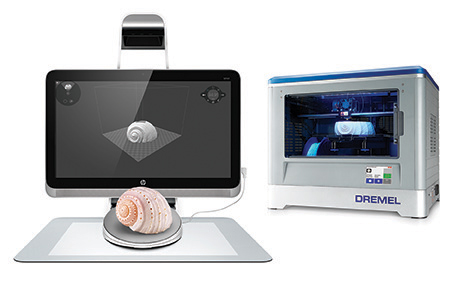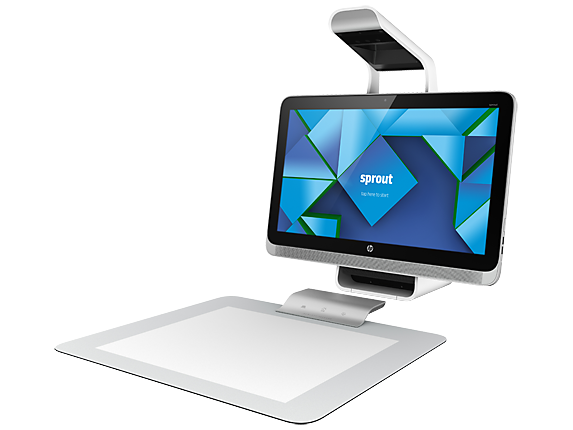
HP is working with Dremel to provide an end-to-end, scan-to-print solution with the Dremel 3D Idea Builder printer. Image Courtesy of HP
Latest News
June 16, 2015
Don't let appearances fool you. By the looks of it, HP's Sprout immersive computer, now more than six months old, seems to be just another in a long line of devices trying to capture the hearts and minds of DIY-conscious consumers looking to create and output 3D content. Yet the addition of a new 3D scanning capability that facilitates a complete design workflow may be just what it takes to root Sprout in the professional engineering segment.
New to the HP Sprout, touted as the first immersive computer, is an integrated desktop 3D scanning turntable that serves as a platform for objects to be scanned into the system for subsequent 3D modeling and editing work. This new proprietary 3D Capture Stage, as it's called, joins Sprout's existing hardware — a touch screen computer, Intel Real Sense 3D cameras and a projector that lets users interact with the digital elements via a canvas placed in front of the screen — along with HP's own 3D capture software.
 HP's Sprout now features a 3D Capture Stage accessory for capturing and scanning physical objects. Image Courtesy of HP
HP's Sprout now features a 3D Capture Stage accessory for capturing and scanning physical objects. Image Courtesy of HPAs an immersive system, the Sprout was born from HP's vision of “blended reality,” which is designed to let users go from thought to expression in an instant, according to Eric Monsef, Highly Immersive Systems, HP. The new scanning platform, which lets users do a complete 360° scan of an object placed on the turntable with the push of a button, is intended to take what's traditionally been relegated to a professional audience and open it up to larger mass of consumers, Monsef said.
At the same time, however, Sprout is not just a hobbyist bid by HP to empower the general population with a means of personal expression. Monsef says the system has plenty of potential for professional engineers looking to create and share libraries of CAD designs.
Good for Pros?
“This is really about being able to get ideas into a digital form rapidly,” he explained. “Our roadmap for Sprout addresses both the professional and consumer markets.”
For example, think about what a designer might traditionally do in molded clay or foam as part of the early concept stage. With the new 3D capture and scanning capabilities of Sprout, those unformed ideas can easily be brought into the traditional CAD workflow as a 3D model and further refined over the course of the design process. “Any thing you can shape by hand — it's all about getting into the CAD workflow,” Monsef explained.
Sprout's 3D Capture Stage turntable automatically tilts 15° while turning to ensure that the entirety of an object is captured for each design — hence the 360° scan. Accompanying the hardware is a new version of the 3D Capture application, which creates a full 3D digital model that can be manipulated. 3D Capture is being introduced as a free upgrade to the current 3D Snapshot software offered with Sprout, which only captures a single side of an object.
 HP is working with Dremel to provide an end-to-end, scan-to-print solution with the Dremel 3D Idea Builder printer. Image Courtesy of HP
HP is working with Dremel to provide an end-to-end, scan-to-print solution with the Dremel 3D Idea Builder printer. Image Courtesy of HPHP is also playing up the sharing capabilities of the new system. Sprout users can share 3D objects via a feature that lets others view and manipulate them by rotating or resizing objects in an online 3D viewer. Users can also post the resulting 3D images to Facebook or other social sites — a sharing capability that's more apt to appeal to hobbyists and DIYers as opposed to professional engineers.
HP has also forged a partnership with Dremel to make it easy to 3D print the resulting 3D objects with the Dremel 3D idea Builder printer. There are other partnerships with service providers so Sprout-produced 3D models can be 3D printed and available for delivery by mail.
Sprout, now available through commercial retailers and distributors in the United States, is priced starting at $1,899.99. The 3D Capture Stage accessory, to be available in July, costs $299.
Check out this video to get the basics on Sprout and what it can do.
Subscribe to our FREE magazine, FREE email newsletters or both!
Latest News
About the Author
Beth Stackpole is a contributing editor to Digital Engineering. Send e-mail about this article to [email protected].
Follow DE





